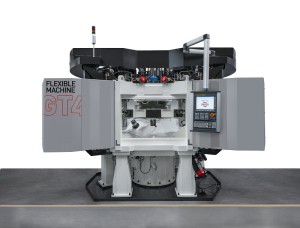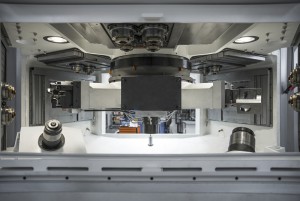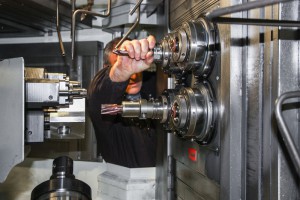
Gnutti transfer has implemented a new generation of transfer machines, able to face the complexity and the competitiveness of the automotive sector successfully.
Automotive manufacturing: a mixed blessing for the players in the mechanical machining industry. Source of concern because the automotive market is highly competitive and characterized by very high-level requisites, blessing because cars, born at the end of the Nineteenth century, still fascinate and boost the inventiveness and the creativity of engineers and designers.
The automotive market, even if affected by the setbacks caused by the recent economic crises, is still an outstanding and irreplaceable source of job orders for the mechanical industry and certainly a “technology driver” that always challenges machine tool manufacturers.
Automotive, in particular, is today one of the reference sectors for the transfer machine builder Gnutti Transfer in Brescia. This because the Brescia business, with a constant activity of study, research and development that employs 4-5% of its turnover, has managed to implement a new generation of highly flexible transfer machines, able to grant the big production volumes required by the automotive industry and anyway typical of transfer machines, combining them with innovative skills in terms of precision, repeatability, flexibility and reconfigurability. We are going to see in what manner, interviewing Benedetta Gnutti and Alberto Rodenghi, respectively Marketing Manager and Proposal Engineer of Gnutti Transfer.

The machine and its characteristics
The Flexible Transfer Machine is a multi-station transfer machine (4, 6, 8). The single stations are equipped with modular operating units GT 2 and GT4 (see box) mounted on a cross saddle, with a very flexible configuration. Each module will have 3 axes: CNC-controlled and independent X, Y and Z, therefore, when a Z axis works, the other will be in rest position.
”Besides, – explains Mr Rodenghi – if we consider a GT4 module, it is provided with 4 spindles, then in comparison with a standard machine it is possible to save at least 3 tool changes, which means a saving that ranges from at least 8 to 16 seconds”. “Without considering the intrinsic reliability, high stiffness and simplicity of the system – adds Mr Rodenghi – based on the fact that each tool is provided with a dedicated spindle line and the independent axes prevent any collision risk”.

The reasons for flexibility
If the Flexible Transfer Machine, with its modular units, convincingly appears as a reliable, productive and precise machine, we are going to see here what are its flexibility features.
“First of all – explains us Mr Rodenghi – the units with two and four spindles allow configuring the machine at best, depending on the productive cycle to be carried out; it is possible to devise a configuration of modular units leaving some spindles free, in order to be able to face, in the future, enlargements or modifications of the productive cycle with the same machine, without interventions and upgrading costs”. The second – very important– flexibility factor is given by the piece locking and clamping systems equipping the Flexible Transfer Machine: besides the usual self-centring vices, it is possible to mount semi-self-centring systems, vices and jaws rotating in continuous and special clamping systems purposely studied for the design of the part to be produced.
In this case, too, since the machine can be reconfigured, it is possible to replace clamping systems one another in order to grant the possibility of machining very different parts while still assuring the same quality requisites on the finished product, typical of automotive.
Finally, as Benedetta Gnutti explains us: “The Flexible Transfer Machine can be equipped with any kind of necessary device for the accomplishment of the productive cycle, as it typically happens with the transfer technology: from milling heads to recess ones controlled by CNC, from deep drilling units to roll-threading systems, from profiling to in-process measuring devices, without considering the extreme simplicity with which the machine can face typical turning operations”.
Concerning the in-process measuring performance, the Flexible Transfer Machine offers the possibility of controlling the entire productive process directly on machine board.
“With the Flexible Transfer Machine and with the transfer technology – adds Benedetta Gnutti – we have implemented a product, able to simplify and optimize a productive process, which was immediately successful on the market, as witnessed by the excellent commercial results that we are achieving”.
 Target: decreasing the cost/price
Target: decreasing the cost/price
“One of the standard features of Transfer technology – states Benedetta Gnutti – consists in manufacturing medium-big batches at a competitive cost, in order to increase users’ marginal profitability. With Flexible Transfer Machine we have transferred this factor to the automotive industry, implementing a machine that, nowadays, becomes interesting also for the subcontracting world”. As we know, in fact, the broad and powerful Italian subcontracting industry can boast big automotive OEM among its customers and Italian subcontractors are called every day to cope with the piece cost challenge, an essential parameter for the acquisition of job orders. The Flexible Transfer Machine is certainly an extraordinary ally to win this challenge and, in the subcontracting case, thanks to its reconfigurability, it can share successfully in several other machining processes, also in other subcontracting fields. 
The technological trends of the automotive sector
Always, or at least since the epoch in which Ford production system consolidated, the car manufacturing is characterized by big production volumes, with the machining of mechanical parts and components in huge batches. This aspect was summed, in more and more exasperate way, starting from the Eighties of the Twentieth Century, to the total quality requisite, with the zero defect production; finally, the Toyota system got a footing, leading companies to conform to the productive, quantitative and qualitative requirements, according to a strategy of extreme attention to the production inexpensiveness and to doing “more with less”. As states Benedetta Gnutti: “All this has led to the current situation of the automotive sector, which witnesses the persistence of medium-big manufacturing batches, with the need of complying with stricter and stricter piece tolerances and of granting measurable and demonstrable repeatability in statistical manner on the whole batch entity”.
“So much severity is understandable – adds Benedetta Gnutti – because the high quality has a direct and positive impact on the safety and reliability of the vehicle and then on end-users’ satisfaction; besides, automotive companies exact the highest quality of components because today releasing a new model on the market calls for a huge investment of resources and capitals”.
Another aspect of the automotive industry evolution can be easily observed also by the players not operating in this sector, simply analysing the advertising campaigns of manufacturing companies: with the proposal of brand-new versions or the restyling of those already in the catalogue, today a car model remains on the market about three years against the five-seven years of the past. This, explains us Benedetta Gnutti, has a precise consequence on production plants: “We need flexible machines, which can be reconfigured in case the design of the produced parts changes. If a car model changes, the car must suit the production transformation, otherwise it would soon become obsolete”.
This is the reason why, in the automotive sector, machining centres enjoy great favour in mechanical workshops, especially by subcontractors that work for big automotive OEM: the CNC machining centre is certainly a versatile and flexible machine, which well suits the fast changeovers.
However, Gnutti Transfer today proposes a solution, obviously based on the transfer technology, which has met lively success in the automotive industry. As affirms Benedetta Gnutti: “The transfer technology offers reliability and productivity and therefore, for the first time, transfer machines can replace our transfers because they manage to be productive, complying with the very high quality standards exacted by the sector and offering new potentialities in terms of flexibility and reconfigurability; we are referring in particular to the Flexible Transfer Machine, equipped with GT2 and GT4 units, respectively with two and four spindles”.



